Capital:
Sucre
Currency
Bolivian
Best time to visit:
The ideal season to travel is the dry one (from mid-March to mid-November). At high altitudes (so practically everywhere!) The nights are cold, even when it is hot and sunny during the day.
In a word:
Buenos dias sopita, qué tal? (hi, everything ok?)
Vaccines
Nobody, but do not underestimate the danger of soroche: "altitude sickness". Learn to recognize its symptoms (nausea, headache, fatigue) and to prevent it (sleep at an altitude lower than that reached during the day, descend an additional 500 meters in case of discomfort).
At the table:
The menu usually includes potatoes, often fried, rice, corn and chicken (grilled, roasted or fried). Almost all dishes are a little spicy due to the addition of llajua, a chilli sauce. The dumplings stuffed with meat (empanadas, saltenas and tucumanas) including tamales (with corn flour) are excellent.


Warnings:
- It is important for both children and adults to gradually acclimate to the altitude. You can land in Santa Cruz and visit the plains first, then climb to Samaipata (1650m) and visit the fort before climbing the mountain.
Essential experiences:
Night in a salt hotel in Uyuni; Relax in the sulphurous waters of the Salares; Stroll around the cobbled streets of La Paz
Bolivia is not called the Tibet of the Americas for nothing: it is the highest, most isolated and most rugged nation in the western hemisphere. Most of the population claims pure Indian blood and many retain the cultural values and beliefs of their ancestors. The geography of this Andean landlocked country ranges from jagged peaks and endless salt pans to jungles filled with steam and pampas rich in wildlife. Bolivia is often left out of the itineraries of travelers, making it the perfect destination outside the box.
After spending a few days in the colorful former capital of La Paz, with a night bus we reach Uyuni just in time to rent an off-road vehicle and get lost in the wonderful salt desert of the Salares, a unique place in the world! Three days between enchanting landscapes never seen before, a full immersion from which we will come out changed!
Our suggested itinerary (12 days) | |
three days: | La Paz, Valley of the Moon |
one day: | Chacaltaya |
four days: | Uyuni, Laguna Colorada |
three days: | La Paz, Tiwanaku |
| one day: | transfer to Peru by land or flight to major South American cities and beyond |
By an old public bus we leave the city behind us and, along Lake Titicaca, we head towards Kasani: border between Peru and Bolivia.
The entry formalities are very slow and the police do not seem very cooperative, we even have to pay the immigration papers! Absurd! But borders are like that!
We enter Bolivia, from Perù, by land. We are immersed in the chaos without rules of La Paz, everywhere cars, vans, people, women with the black bowler hat on the side of the road selling fruit and vegetables ...
We leave early in the morning for the Valley of the Moon.
The sky is clear, the sun hot and the air brisk ... no name was more appropriate for this lunar landscape very similar to Cappadocia!
We soon head towards the majestic Chacaltaya Glacier. The road starts to climb and slowly begins to shrink and runs along frightening cliffs ... there is a bit of tension but twenty minutes later we reach an altitude of 5335 meters!
I drink a mate de coca in the refuge while a postcard-like landscape appears in front of my dreamy eyes!


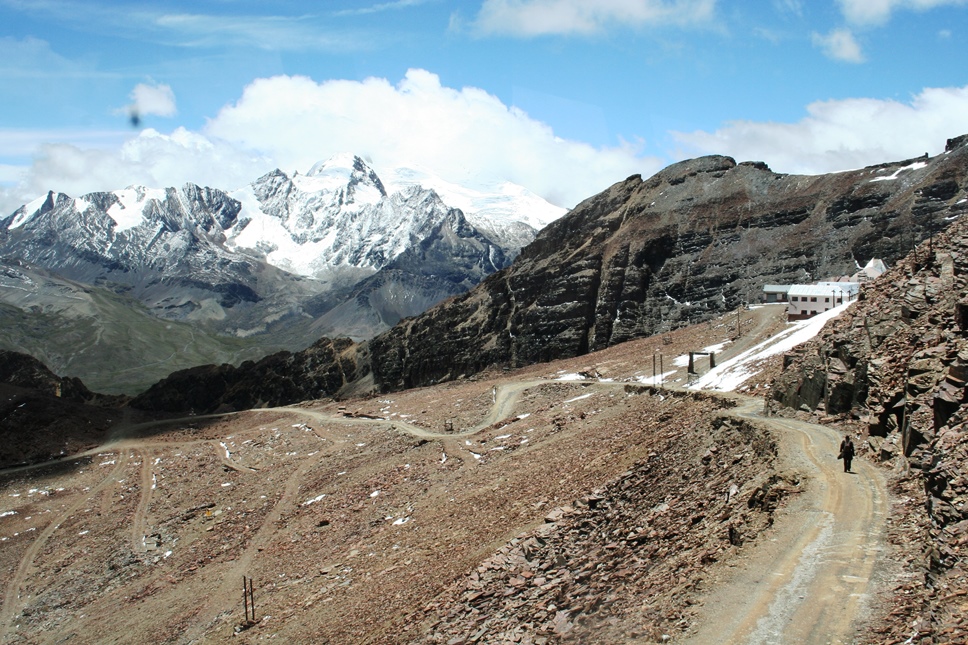
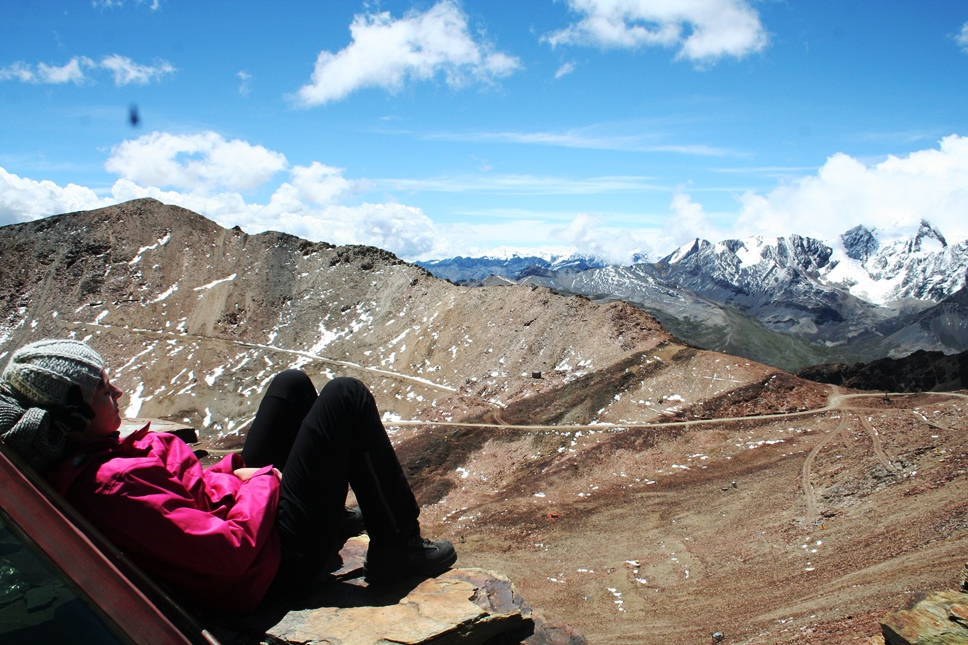




On the way back to La Paz we take the necessary for the next three days in the Salares and in the late afternoon we depart from the Bus Terminal to the south of Bolivia: Uyuni.
We will travel all night.
We arrive in Uyuni at about 6.00 am when it is about to dawn and the town is completely deserted. We find everything closed, it looks like a Far West scenario!
We stop to eat a little something as the city slowly begins to wake up: the children come out of their homes to go to school all in uniform, the first banquets of handicrafts or spices appear, everything starts to come alive ...
A little later we are on board our three SUVs ready to live this unforgettable yet another experience!
Train Cemetery. Wagons abandoned along a rusty railway, witnesses of a bygone era!
Finally we leave for the salares! The light is blinding, like being in an enchanted world! We set foot on the ground and our shoes are filled with water and salt ...
... cameras go crazy! The reverberation of light and clouds on water created very suggestive effects!
We are ecstatic and we stay until sunset ... the sun goes down and dyes everything with red, yellow, violet ... everything is reflected and disorientates us ...





















We go back to our salt camp, yes, it's made of salt bricks, even the bed and chairs are made of salt! We are so tired!
We leave at dawn for the Desert of Siloli at 4800 meters!
Here is the Laguna Cañapa and the first pink flamingos ...
Laguna Honda with its borax quarries.
We spend the whole morning among surreal landscapes ... we stop in nothingness and our drivers prepare a great banquet that we enjoy with pleasure!
We continue our journey crossing boundless, magical spaces until we reach the Arbol de Piedra, a natural sculpture among taller rocks with the strangest shapes!











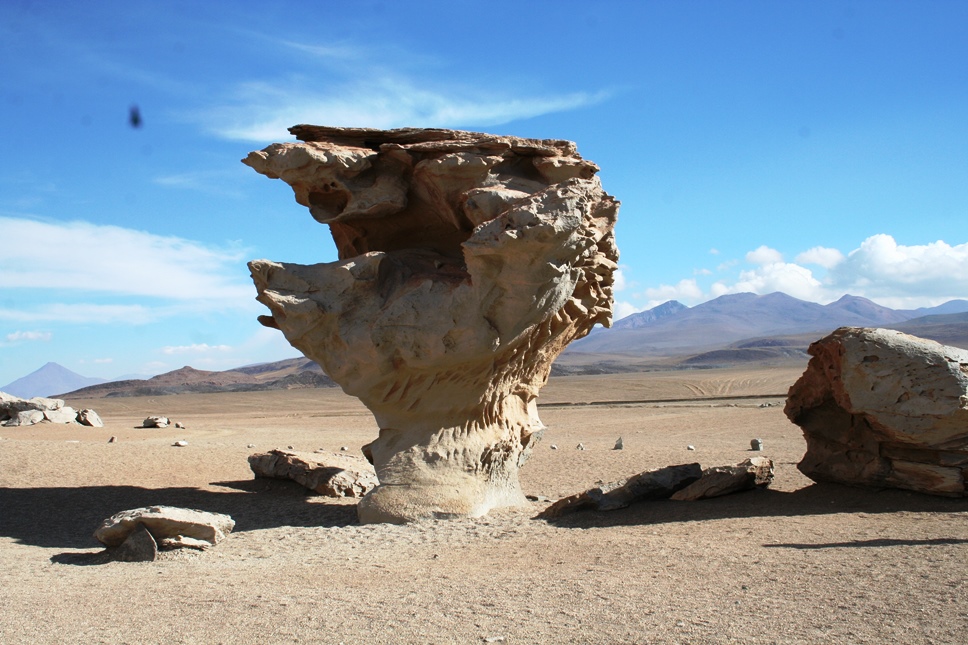


"The roots are important, in a man's life, but we men have legs, not roots, and legs are made to go elsewhere."
- Pino Cacucci -
In the afternoon we reach the Laguna Colorada where our eyes are literally kidnapped by the red color, the stripes of borax in the background and like pink brushstrokes here appear, on this perfect picture, dozens and dozens of elegant flamingos!
There is a strong cold wind, we decide to move towards our new camp, even more spartan than yesterday but it doesn't matter!
The dusty roads lead us, when it is still dawning, to discover the last treasures of this part of southern Bolivia.
Teodoro, the driver, tames our off-road vehicle and, along the umpteenth postcard lagoon, shows us, in the distance, high vapors sprayed towards the sky.
There is a great smell of sulfur and the scenery is very suggestive.
These geysers, fumes that come out of the earth, almost like the breath of a giant when it's cold outside ... and it's really cold outside, now are days that we don't go below 4000 meters and it seems that our physicists have become accustomed!
Not far away the background changes again, almost as if you were flipping through a photo album with a thousand images taken in faraway places and all different from each other!
Suddenly immense sand dunes adorned with gigantic rocks very characteristic and out of place ... almost like falling from the sky disorderly. They are the Rocas de Dalì, so named because they inspired the famous Spanish painter.
Someone relaxes a little at the spa of Polques soaking at 38 ° before reaching the Laguna Catal!
Teodoro is very keen to show us this enchanted place! A real Eden! Llamas and donkeys that graze peacefully while various species of birds fly happily on this fantastic lagoon!
But our goal is more than eight hours of rough road: we go back to Uyuni but only for a couple of hours, tonight we have the night bus for the city of La Paz!
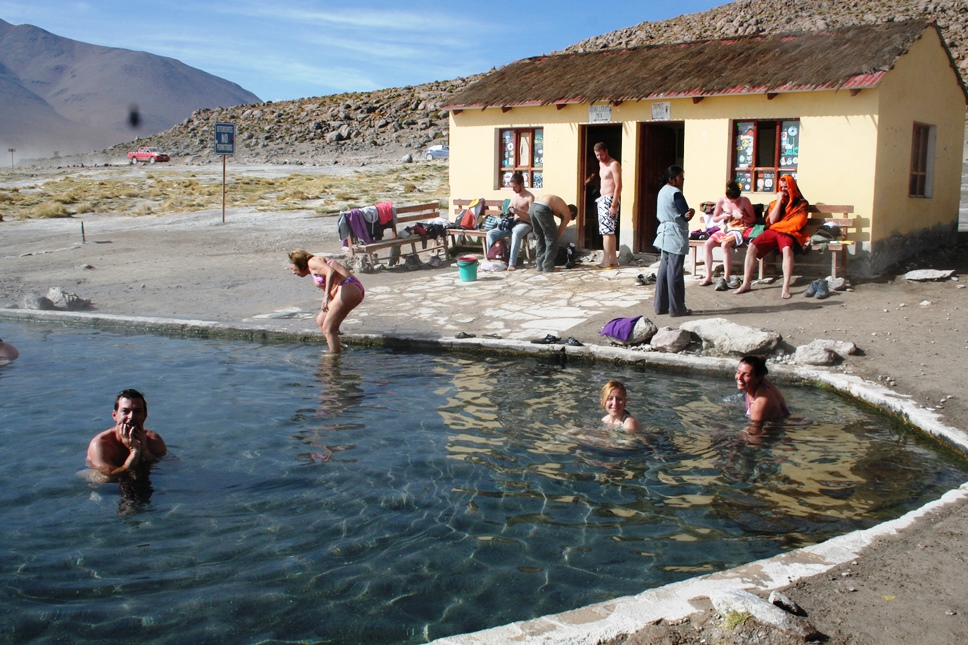
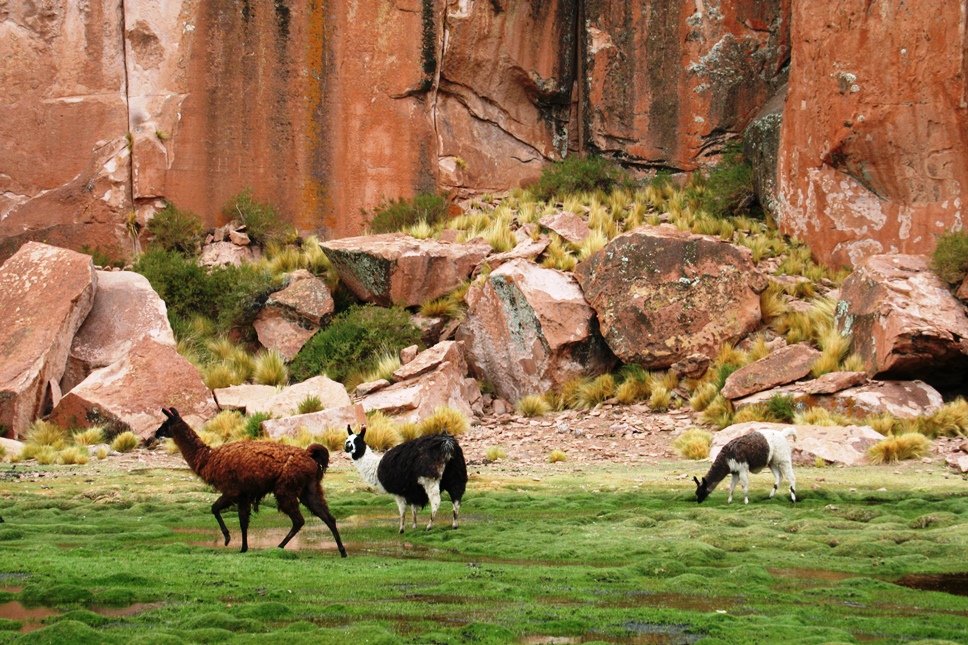





After an entire night of travel, at dawn we enter the already crowded outskirts of this town!
From Plaza de España we take the cable car and climb up, higher and higher, where we enjoy a marvelous view of La Paz, the only city where the poor neighborhoods are high up and the wealthy people below.
Once we arrive at our destination we end up in the middle of a political demonstration where men and women dressed in white-blue, the colors of propaganda, parade! Women in local dresses with the black bowler hat held in balance by some kind of magic.
Better to change area: we go to a fair view just before the taxi.
Here we are between banquets selling barbie dresses or miniature products; women who cook grilled meat and potatoes; so many seers who chase away evil eyes ... it is really true that wandering aimlessly takes you to unexpected and characteristic places!


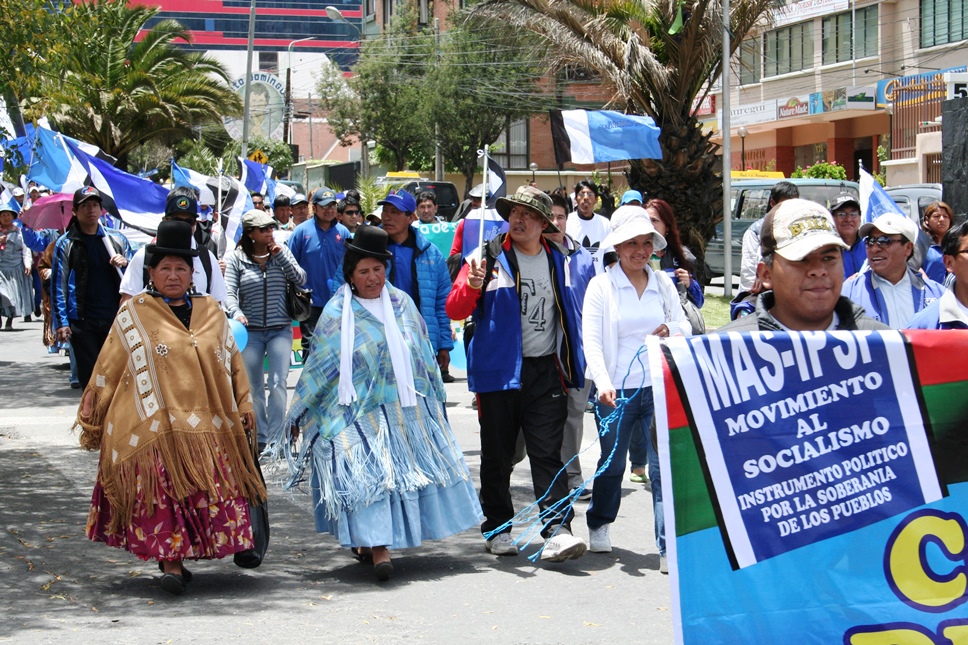








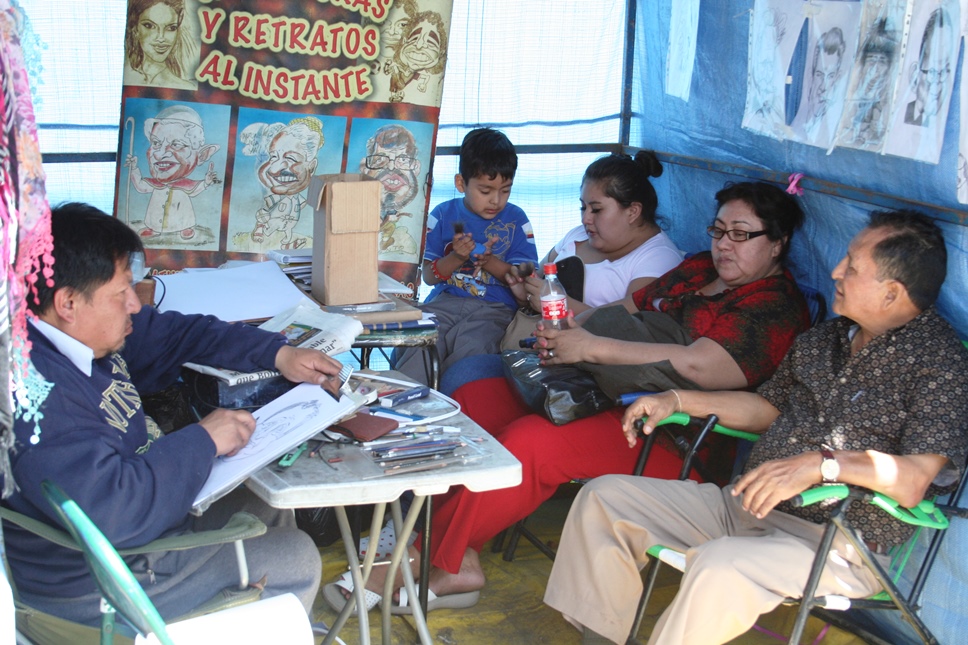
Before leaving this nation, which in a few days gave us unforgettable emotions, we stop at the archaeological complex of Tiwanaku.
The Tiwanaku culture was an important pre-Columbian civilization whose territory extended around the borders of the current states of Bolivia, Peru and Chile. It takes its name from the ruins of the ancient city of the same name, near the southeastern shore of Lake Titicaca. Tiwanaku is much larger than what has been discovered so far. Thanks to a study with satellite images and drones it seems that it has a surface at least double compared to the one so far known.
Not far away is Desaguadero, a border between Bolivia and Peru.
Usual chaos in all borders, however, in less than no time we are on another bus bound for Puno, Perù!
Error: No feed found.
Please go to the Instagram Feed settings page to create a feed.
8 Responses
Come sempre vostri viaggi non deludono mai. Stupendo. Leggendovi viaggio con voi e aumento sempre i miei sogni ❤️ Grazie.
Sei sempre gentilissima…se riusciamo a trasmettere qualcosa allora abbiamo raggiunto il nostro obiettivo. grazie di cuore
Meraviglioso ..il video, il vostro racconto…bellissimo
grazie mille
Meraviglioso ..il video, il vostro racconto…bellissimo
Grazie mille, fa sempre piacere ricevere feedbacks positivi da chi è del settore
GRACIAS PR VISITAR MI PAÍS, LES DESEO BUENAS RUTAS
Es un Pais lindissimo…we cant wait to come back there again!